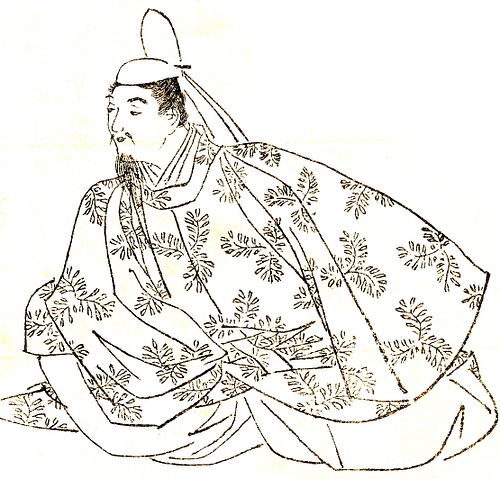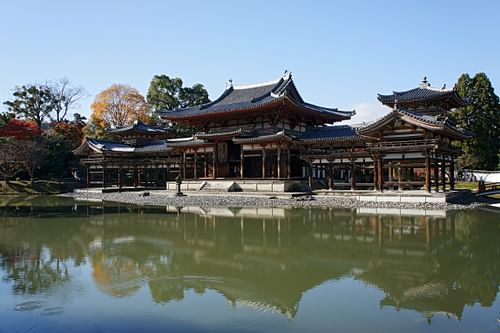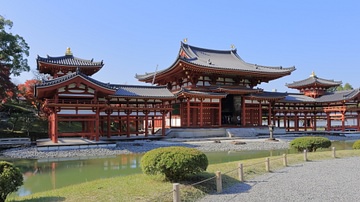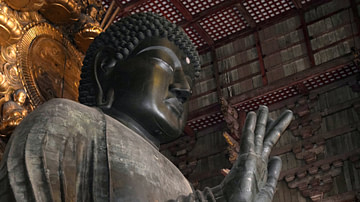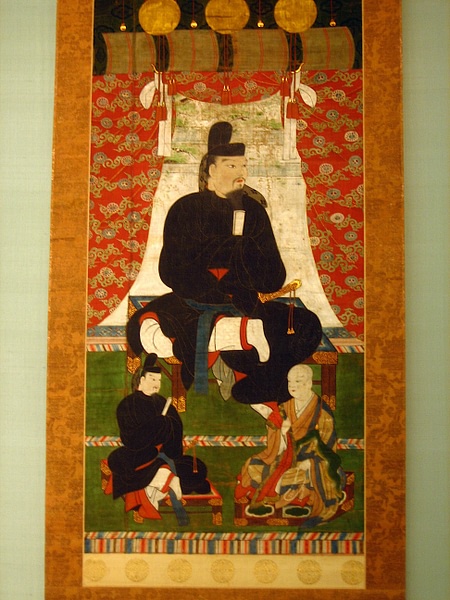
The Fujiwara clan (Fujiwara-shi) was a powerful extended family group which dominated all areas of Japanese government during the Heian Period (794-1185). Founded by Fujiwara no Kamatari in 645 CE, male members held on to key official positions, many acting as regents to the emperor, and ensured their daughters married into the imperial line. By the 12th century CE, Fujiwara power declined as successive emperors abdicated in favour of their own chosen heir while still maintaining their hold on power in retirement. The Fujiwara were ultimately replaced by the rival Taira and Minamoto clans.
Fujiwara no Kamatari
In the 7th century CE the court official Nakatomi, later to become Fujiwara no Kamatari (614-669 CE), became a useful ally to Prince Naka no Oe, and together they staged a coup in 645 CE which deposed the powerful Soga clan who had hitherto dominated government positions and were threatening to usurp the power of the emperor. A series of political reforms were then initiated, known as the Taika Reforms (Taika No Kaishin). These reforms were based on the Chinese model of strong central government and they nationalised land, reorganised the court ranking system, forbade the ownership of unauthorised weapons, and attempted to root out corruption. When the Prince became Emperor Tenji (661-671), he gave Nakatomi and his descendants the surname Fujiwara and made him his special minister.
Kamatari's son Fubito (aka Fuhito, 659-720 CE) married the daughter of Emperor Mommu, and his four grandsons each formed the four branches of the Fujiwara clan: Nanke (Southern House), Hokke (Northern House), Shikike (Ceremonials House), and Kyoke (Capital House). The Fujiwara line was now firmly established and they would keep a tenacious grip on power as they not only dominated policy and government bodies such as the household treasury office (kurando-dokoro) and Council of State but also managed to marry off their daughters to emperors.
Further weakening the royal position was the fact that many emperors took the throne as children and so were governed by a regent (Sessho), usually a representative of the Fujiwara family. In total there would be 21 Fujiwara regents from 804 CE to 1238 CE. Even when the emperor reached adulthood, he was still advised by a new position, the Kampaku, which ensured the Fujiwara maintained their influence. To guarantee this situation was perpetuated new emperors were nominated not by birth but by their sponsors and encouraged or forced to abdicate when in their thirties in favour of a younger successor. Thus, for example, between 858 and 956 CE there were 10 different emperors. As a consequence, key Fujiwara members could act as regent to three or four successive emperors in their own lifetime.
Fujiwara no Yoshifusa
One such figure was Fujiwara no Yoshifusa (804-872 CE) who was the clan leader (uji no choja) from 858 CE. He put his seven-year-old grandson on the throne in 858 CE and then formally became his regent in 866 CE. This was the first time a regent had not been of royal blood and it established a trend that would continue into the 11th century CE. The Fujiwara, and especially the Northern House, now had direct control over the emperors, and so there was no need to remove the institution, although individuals who proved less than cooperative could be forced into abdication and one or two emperors disappeared in mysterious circumstances or ended up in monasteries. In addition, the clan's own private militia ensured that their position was never seriously threatened by outsiders.
Internal Rivalries
Fujiwara control was almost total but there were threats from within. Rivals jockeyed for position within the state apparatus and in the provinces where government control was weaker. The northern Fujiwara, for example, had established a prosperous administrative base at Hiraizumi in northern Honshu and their dominance was repeatedly challenged by the other branches of the clan. One notable rebellion was led by the clan rebel Fujiwara no Sumitomo in the Iyo province on Shikoku. He commanded a large pirate fleet that plagued the sea between Japan and mainland Asia, and he became a hero to the local hard-pressed peasants when he attacked government granaries. The rebellion was soon quashed, though, following Sumitomo's death in 941 CE. Still, the Fujiwara was now such a widespread organisation with so many branches it was almost inevitable that there would be disputes over who should be its leading figure and have the coveted responsibility and control of the clan's lands, income, and civil appointments. The clan also controlled many temples and shrines, including such jewels as Byodo-in at Uji and the Fujiwara family temple, the Kofuku-ji complex in Nara, founded in 669 CE.
Fujiwara no Michinaga
Another important Fujiwara figure was Michinaga (966-1028 CE) who became the clan's leader in 995 CE. During his 30-year reign as the most powerful individual in Japan, he married off four daughters to four emperors and so eventually came to have an impressive four emperors as grandsons. The Fujiwara were at their zenith and Michinaga could claim in his famous poem: “No waning in the glory of the full moon - this world is indeed my world!” (Whitney Hall, 70). Michinaga retired from politics and became a Buddhist monk in 1019 CE - he had already prepared the way by founding the Hojoji temple - but he still pulled the strings of power through his son Yorimichi (992-1074 CE). When he died in 1027 CE, Michinaga was said to have clasped in his hands strings of a different kind, silk cords which ran to several statues of the bodhisattva Amida in the hope that they would pull him to the Pure Land of the Buddhist afterlife. Michinaga's life became the subject of the Eiga monogatari, an 11th century CE history.
Decline in Power
The dominance of the Fujiwara was not quite total and did not always go unchallenged. One of the first attempts by the emperors to reassert their power and independence was by Emperor Uda. He sought to break the Fujiwara monopoly by promoting one Sugawara Michizane (845-903 CE), an outsider of lowly social rank, to the high position of Minister of the Right and a member of the Council of State in 899 CE. In 901 CE, the Fujiwara fought back and concocted an accusation of treason against Sugawara with the result that he was effectively exiled. Sugawara would get his revenge when certain disasters befell the palace and state following his death, ultimately even being officially deified as the Shinto god of scholarship under the honorary title of Tenjin. Nevertheless, for the Fujiwara, normal service had resumed.
Emperor Shirakawa (r. 1073-1087 CE) attempted to assert his independence from the Fujiwara by abdicating in 1087 CE and allowing his son Horikawa to reign under his supervision. Shirakawa's own father, Emperor Go-Sanjo (r. 1068-1073 CE) had done exactly the same but had died a year after abdicating. Shirakawa, on the other hand, ruled behind the scenes for over three decades. Emperors, from that time on, also created their own bureaucracy of power similar to that of the Fujiwara clan. This strategy of 'retired' emperors still, in effect, governing became known as 'cloistered government' (insei) as the emperor usually remained behind closed doors in a monastery.
In the provinces, new forces were emerging which would challenge the dominance of the Fujiwara even more seriously. Left to their own devices and fuelled by blood from the minor nobility produced by the process of dynastic shedding (when an emperor or aristocrat had too many children they were removed from the line of inheritance), two important groups evolved, the Minamoto (aka Genji) and Taira (aka Heike) clans. With their own private armies of samurai, they became important instruments in the hands of rival members of the Fujiwara clan's internal power struggle which broke out in the 1156 CE Hogen Disturbance.
In 1156 CE the death of the retired emperor Toba caused a bid for power from two rival groups within the Fujiwara clan, each with their own claimant to be next emperor. Tadamichi Fujiwara supported Go-Shirakawa while his brother Yorinaga sided with the retired emperor Sutoku. The Taira clan sided with the Go-Shirakawa and the Minamoto clan sided with Sutoku, although things were made even more complicated when Yoshitomo, son of the Minamoto leader Tameyoshi, sided with Go-Shirakawa. After the violence rather euphemistically called the Hogen Disturbance (Hogen No Ran) was over, Go-Shirakawa and his supporters had won the day.
The Taira, led by Taira no Kiyomori, eventually swept away all rivals and dominated government for two decades. However, in the Genpei War (1180-1185), the Minamoto returned victorious, and the clan leader, Yoritomo, was given the title of shogun by the emperor. Yoritomo's rule would usher in the Kamakura Period (1185-1333 CE), also known as the Kamakura Shogunate, when Japanese government became dominated by the military.
The Fujiwara may have lost political power but the clan continued as an important aristocratic family with many members continuing to hold titled positions, even if those roles had no direct bearing on government. The provinces were another redoubt for Fujiwara members no longer able to acquire through patronage key positions at court. In later times the clan produced some noted writers and poets, amongst them Fujiwara no Sadaie who in 1205 CE compiled the Shin Kokinshu, an imperial poetry collection.
This content was made possible with generous support from the Great Britain Sasakawa Foundation.
